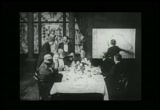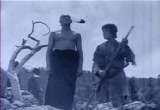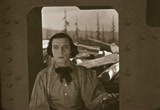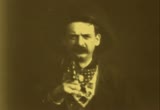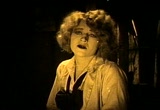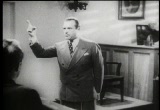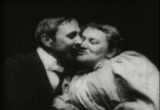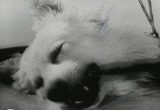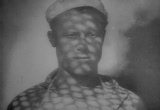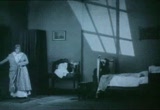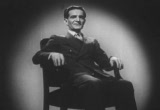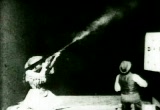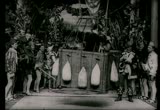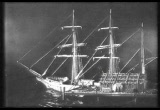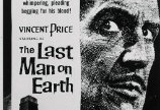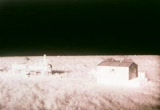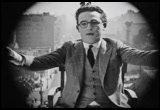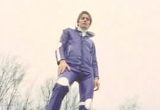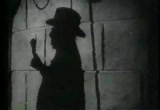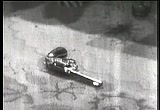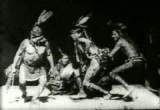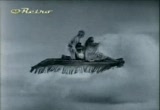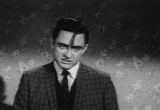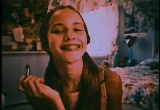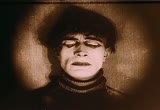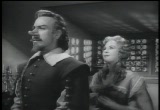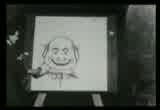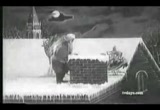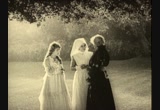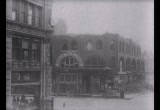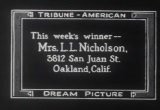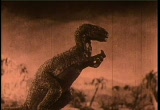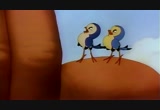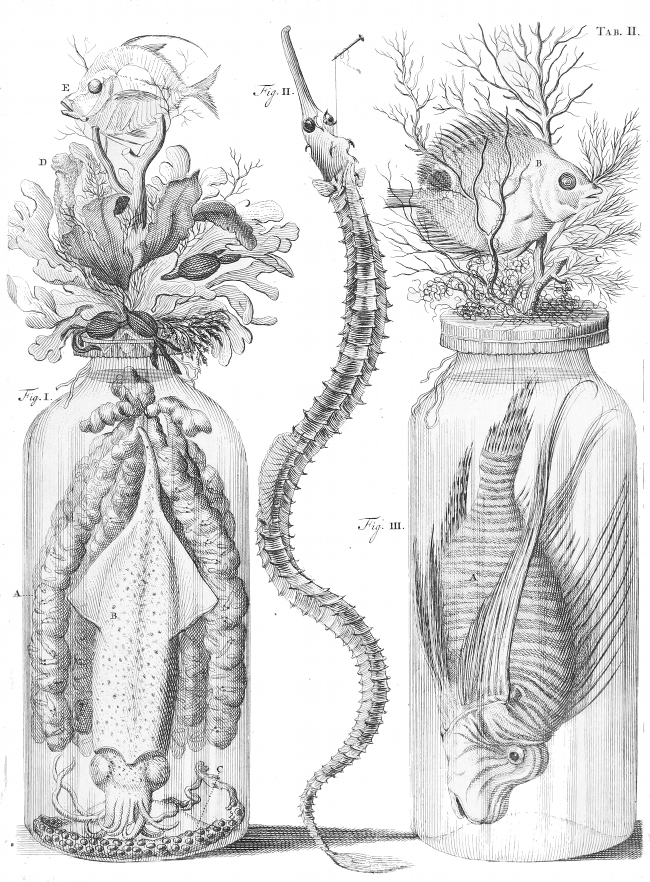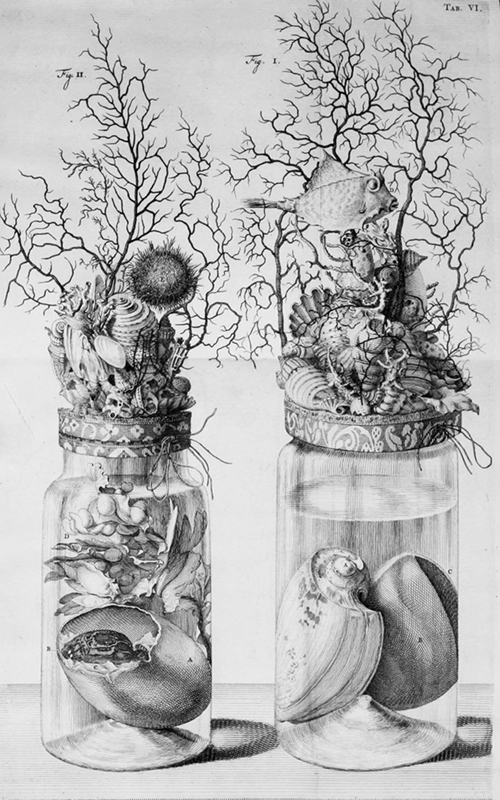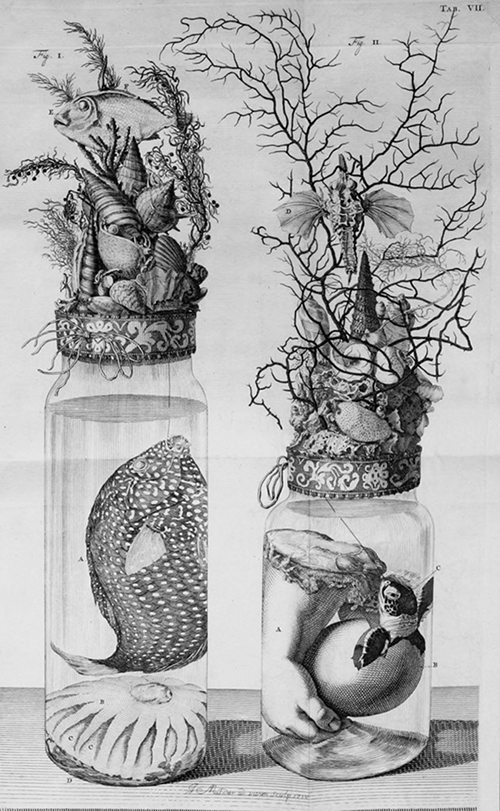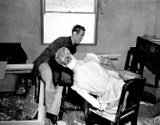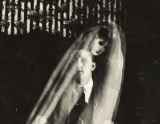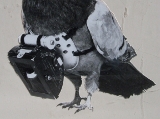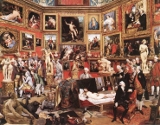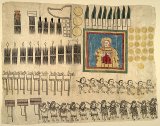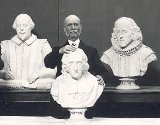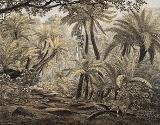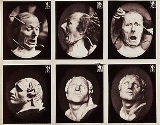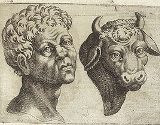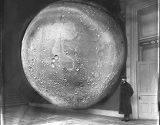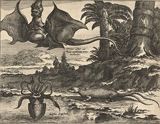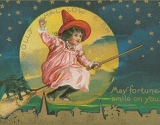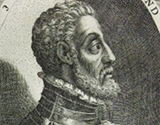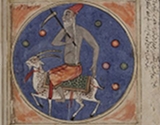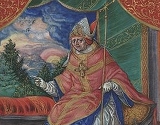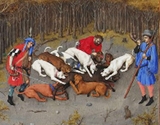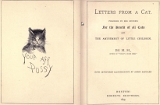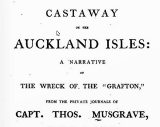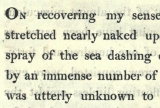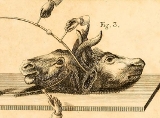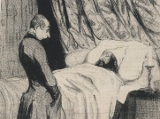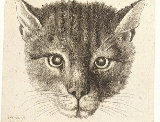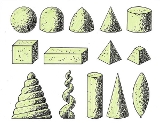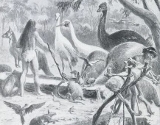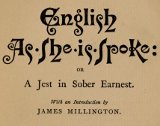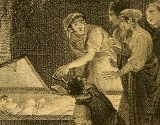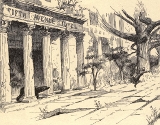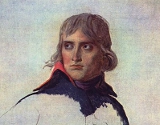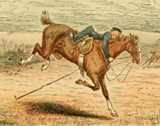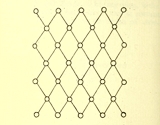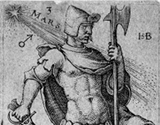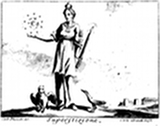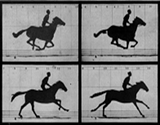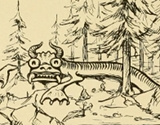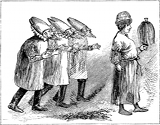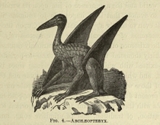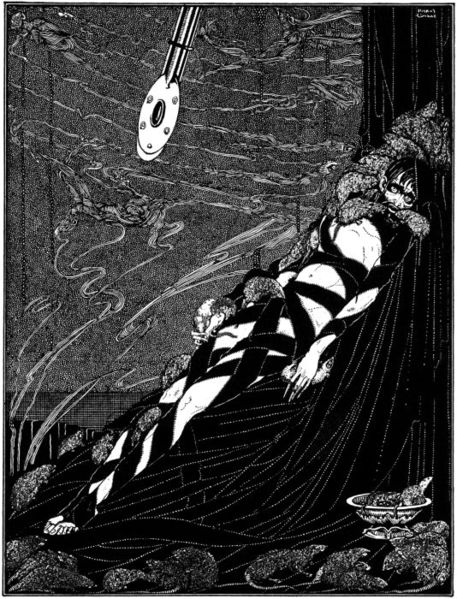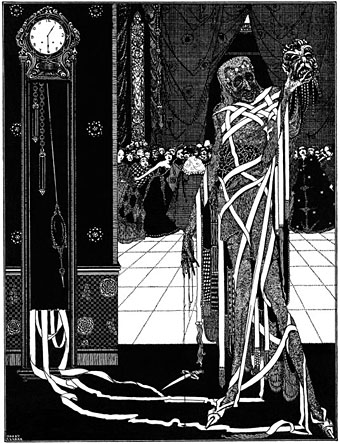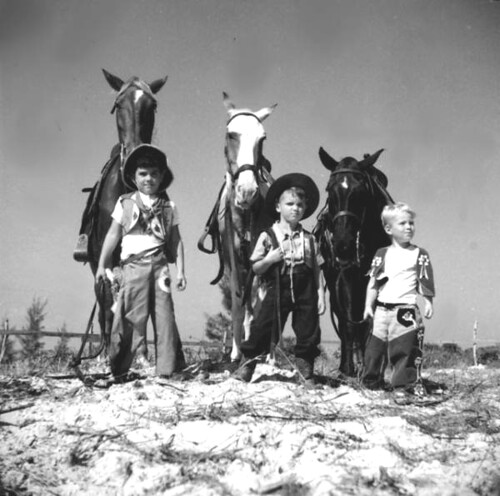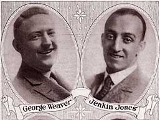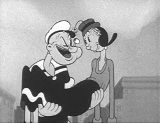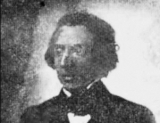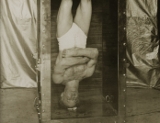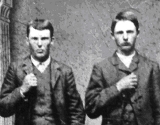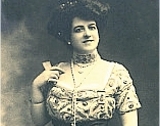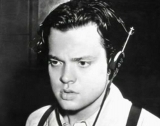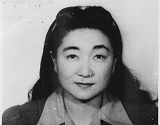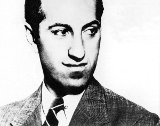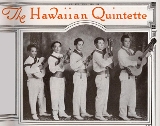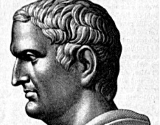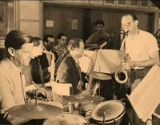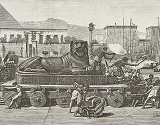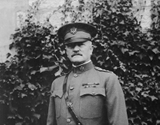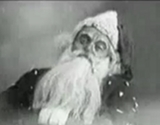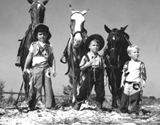Julian Barnes on when a young Guy de Maupassant was invited to lunch at the holiday cottage of Algernon Swinburne. A flayed human hand, pornography, the serving of monkey meat, and inordinate amounts of alcohol, all made for a truly strange Anglo-French encounter.
… and to accompany the article a new translation by Elliot Lewis of Maupassant’s “L’Anglais d’Etretat”.
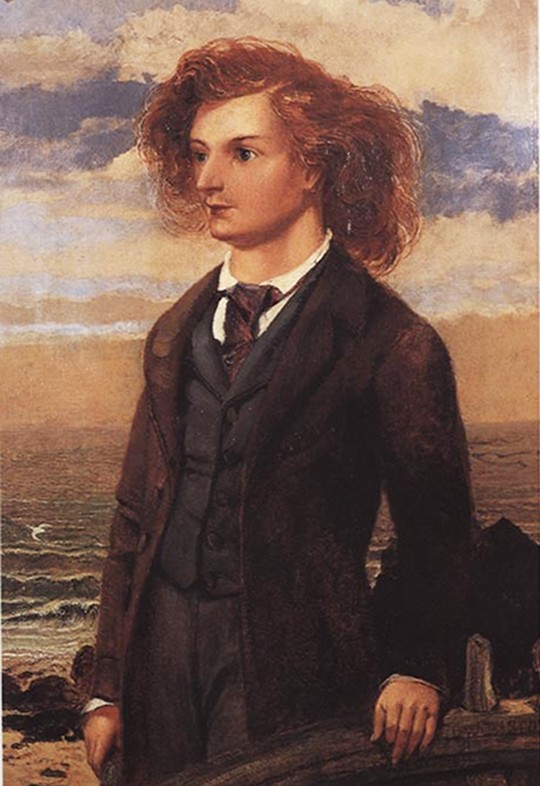
Portrait of Swinburne by William Scott Bell, painted in 1860 when Swinburne was just 23 years old, 6 years before he'd publish his first book of poems.
In the first half of the 19th century, the British began to discover Normandy. Previously, the point of entry into France for most travellers had been Calais, which felt safely half-English, and where even the beggars importuned new arrivals in their own language. Those prepared to make the longer crossing to Dieppe were rewarded with a greater sense of strangeness: typified by the women in red-and-blue regional costume, clacking sabots and high white coifs that made them look like a cross between chefs and nuns. Hazlitt, passing through in 1824, noted that such headdresses were “much the same as those which the Spectator laughed out of countenance a hundred years ago in England”; and he concluded more generally that “In France one lives in the imagination of the past”. For the tourist, this meant antiquities and picturesque ruins within easy reach. The coastline was a further attraction: for those addicted to the new health-kick of sea-bathing, to the gentler pleasures of gambling (the casino at Dieppe opened in 1822), or to painting and sketching. Gradually, the journey from London became quicker – a combination of the London to Brighton railway and the new steam-packets brought the time down to a mere 11 hours by the 1840s. For centuries Dieppe’s main relationship with Britain had consisted of suffering occasional bombardment from the Royal Navy; now there were not just summer tourists, but year-round residents. There was even a quartier des Anglais (on the hill between the Paris road and the chateau), served by an Anglican chaplain and a British consul. And since the French more or less simultaneously decided to make Dieppe a sophisticated destination, the town flourished.
British artists had started coming here as soon as the Napoleonic wars were over. John Sell Cotman delighted in the luminous quality of the Dieppe light (it is an unpatriotic truth that looking north from Dieppe is more visually complex than looking south from Brighton); Turner came several times in the 1820s; Richard Parkes Bonington in the 1830s. We tend to associate the Normandy coastline – Etretat, Pourville, Varengeville, Fécamp – with Monet and the impressionists; but (as with Cézanne and Mont Sainte-Victoire) previous generations of painters had preceded them. Boudin, who later taught Monet the principles, and the necessity, of pleinairisme, painted in Dieppe, as did Corot and Daubigny; while Delacroix came here in 1850 and 1852. His diary contains an unflattering depiction of the English colony, whose invitation he had accepted out of boredom. He went to the salon of a certain Mrs Sheppard, and the next day rebuked himself: “What a fool you are, getting a sore throat from talking to idiots, arguing with petticoated silliness for a whole evening, with everyone going on about God, and ‘the justice of the world’ and ‘good and evil’, and ‘progress’!”
Now that the Channel tunnel has restored most traffic to the more northerly crossing, and the ferry service from Newhaven runs at unfriendly hours, Dieppe has sunk back into being largely French again. Serious war damage makes it harder to recreate in the mind the century – from 1815 to 1914 – during which the town became so fashionable. By the 1850s it had “the smartest and most popular plage in France”; the casino was rebuilt at regular intervals, each time more extravagantly; the British laid out what was only the fourth golf course in France, while the Paris crowd came down for steeplechasing at the new racetrack. The Prince of Wales kept a mistress and perhaps an illegitimate child in Dieppe; Lord Salisbury, while prime minister, built himself a chalet outside the town and maintained that, thanks to the telegraph station at Beachy Head, he was in better contact with London than if he had been on a Scottish grouse moor.
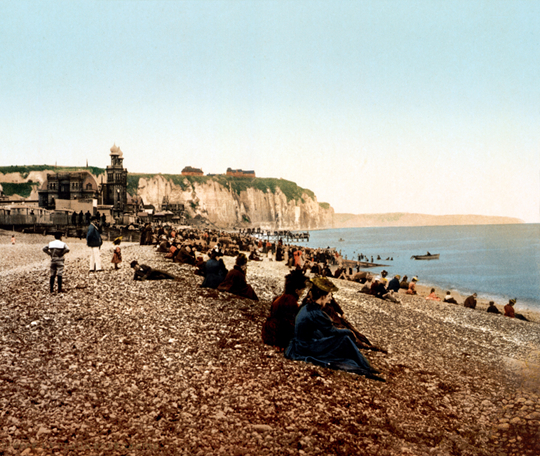
Autochrom photograph of holiday makers relaxing on the beach at Dieppe, ca. 1895
Simona Pakenham, who chronicled Dieppe’s Anglo-French entente in 60 Miles from England (1967), commented tartly that “The English colony was generally indifferent to any form of culture”. But the French needed the arts as the British needed sports. So Liszt played at the Bains Chauds; Meyebeer came; Rossini composed an operetta for the theatre. By the end of the 19th century, the casino summer band was recognised as the best in the country, since it was filled by Parisian orchestral players on holiday. In 1907, one of its violists was promoted to conductor, and surprised everyone by directing all Beethoven’s symphonies from memory: this was Pierre Monteux, who six years later conducted the premiere of The Rite of Spring.
Not all the British visitors were philistines. The town was Sickert’s second home for several decades; and the British feature strongly in the impressive (and highly cosmopolitan) list of belle époque visitors to the town. These include Monet, Pissarro, Whistler, Degas, Renoir, Beardsley, Conder, Fritz Thurlaw (the Norwegian painter), Henry Harland (the editor of The Yellow Book), William Rothenstein, Proust, Saint-Saens, Fauré, Debussy, Maeterlinck, Puvis de Chavannes, Percy Grainger, Adelina Patti, George and Gerald du Maurier, Ernest Dowson, George Moore, Max Beerbohm, Annie Besant, Marie Tempest, John Barrymore and Gladys Cooper. The night boat of May 20 1897 brought Oscar Wilde, freshly sprung from Reading jail and carrying the manuscript of De Profundis. It is a small but interesting footnote to the history of the Dieppe ferry terminal that the two most noteworthy events there both involved pseudonyms. In 1848 Louis-Philippe, the last king of France, heading for exile in England, was hustled aboard a packet of the General Steam and Navigational Company bearing a passport in the suspiciously ordinary name of William Smith. Half a century later, Wilde came ashore, cloaked in the look-at-me alias of Sebastian Melmoth.
The British brought trade, money and work to Dieppe; they laid the railway, and built the town’s station with English bricks. Neither race was or is as hospitable as they like to imagine themselves, but a working cordiality existed between the French and the British. The portrait painter and socialite Jacques-Emile Blanche (1861-1942) operated for many years as a one-man diplomatic service, summering in Dieppe and wintering in London: his studio, just beneath the walls of the castle, was used by Degas, Whistler, Sargent, Boldini, Sickert, Conder, Beardsley and Helleu. “My dear friend,” Henry James said to Blanche, “Your Dieppe is a reduced Florence, every type of character for a novelist seems to gather there” – not that the Great Dieppe Novel was ever written. Such Anglo-French conviviality was helped by a willingness to speak one another’s language. Sickert was regarded as “un vrai Dieppois”, even managing the local fisherfolk’s patois; Wilde and Dowson both spoke and wrote excellent French. So did an English poet whose passing residence along the coast in 1868 led to one of the stranger Anglo-French literary encounters, one that echoed on for decades, in France at least. It also encapsulated the way the French preferred to see the British – and perhaps still do.
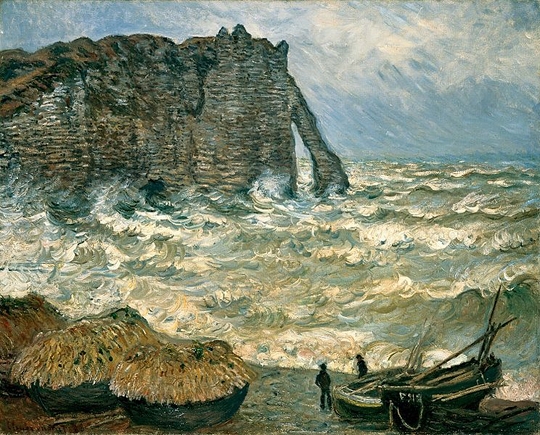
Agitated Sea at Etretat, by Claude Monet from 1883, depicting the famous rocky archway through which Swinburne was swept out to sea in 1868.
Etretat, some 50 miles west of Dieppe, has become a high point of pilgrimage for the artistic faithful, who gather above its white cliffs – especially the one that curves down into a great chalk flying-buttress – to compare eroded reality with visual memories of Monet’s pictures. By 1868 the impressionists had not yet arrived: Etretat was a fishing town that also attracted a certain number of tourists and summer residents. Among their number that year were the 18-year-old Guy de Maupassant and his mother (the family chateau of Miromesnil, where Guy had been born, was a few miles outside Dieppe). The water and its attendant pursuits – swimming, boating, rowing – were to become a thematic constant in Maupassant’s life and work; so it’s appropriate that the water was what provoked the encounter between this muscular, boastfully heterosexual French prose writer and a petite homosexual English poet: Algernon Charles Swinburne.
Swinburne, then aged 31, was staying outside the town in a low thatched cottage belonging to his friend George Powell. The people of Etretat had Frenchly decided that Powell was a milord – even if one modestly concealing his real identity under his mother’s maiden name. (In fact, Powell was his real name, and he was uncoroneted. He was brought up on the family estate at Nanteos, near Aberystwyth, went to Eton and Oxford, and died at 40.) Maupassant later wrote that Powell’s “solitary and bizarre” way of life had astonished the local bourgeois and mariners who were “little used to British fantasies and eccentricities”; he himself was to be afforded a closer look at what such Britishness consisted of.
One September morning, Swinburne went swimming from the beach at Etretat and got into difficulties. According to Powell, treacherous undercurrents had carried the poet out to sea “through a rocky archway” (that very cliff formation Monet later celebrated). Ten minutes later Powell heard shouts from the clifftop that a man was drowning. He ran to the water’s edge, and after a few minutes received the news that Swinburne had been safely picked up by a fishing smack heading for nearby Yport. The poet, writing to his mother (and doubtless downplaying the event), described “a real sea adventure” in which he had been swept two miles out: “Luckily I was all right but very tired, and the result was that I made immense friends with all the fishermen and sailors about – who are quite the nicest people I ever knew.” Maupassant, who was somewhere near the scene, claimed that the poet had been “dead drunk” (despite it being ten o’clock in the morning); also, that he himself had gone out in one of the rescue boats; alternatively, that he had at the very least waded into the water and got soaked to the waist.

Photograph of Maupassant taken by the famous portrait photographer Felix Nadar, ca. 1888, 20 years after his encounter with Swinburne at the Chaumière de Dolmancé.
Whatever the specifics of the near-drowning and the rescue, Maupassant received an invitation to lunch the next day from the grateful Powell. According to Swinburne (again writing to his mother), the place where they lived was an idyllic retreat: “Powell has got the sweetest little farmhouse fitted up with music, books, drawings, etc … and of course he pokes me into the nicest room … There is a wild little garden all uphill, and avenues of trees about. The sea is splendid, and the cliffs very like the Isle of Wight – two arches of rock each side of the bay, and one needle only, exactly like half the Freshwater pair.” Maupassant described his visit to the cottage on three separate occasions: orally to Flaubert, Alphonse Daudet and Edmond de Goncourt in February 1875, an account that Goncourt transcribed into his Journal; in a newspaper article of November 1882 for Le Gaulois (“L’Anglais d’Etretat”)1; and in his introduction to the French translation of Swinburne’s Poems and Ballads in 1891. Though the versions overlap and at times contradict one another, the main story line would have been enough to send the honest burghers of the Isle of Wight scaring up the libel lawyers.
Maupassant noted “an inscription over the door which I didn’t read on that first occasion” – though if he had, he would have known more what to expect. There were pictures everywhere, some “splendid”, others more like “the imaginings of a lunatic”. Powell was short and fat, Swinburne short and thin, “with a pointed face, a hydrocephalous forehead, pigeon-chested, agitated by a trembling which affected his glass with St Vitus’ dance, and talking incessantly like a madman.” Here and there were laid out displays of bones; while a flayed human hand, supposedly that of a parricide, was the bohemian equivalent of a talking point. A large pet monkey was noisily present, being “titillated” by Powell, and trying to shove Maupassant’s head into his glass whenever he took a drink. Lunch included what the Frenchman assumed to be some kind of fish; though when he asked its name, his host “replied with a peculiar smile that it was meat, and I could not get any more out of him.” The fact that spirits rather than wine were served with lunch also struck the young Frenchman as peculiar – though perhaps was not all that surprising. Many of the British who were attracted to France at this time (not just artists and writers, but bankrupts, runaway fraudsters and bogus priests, mixed up with respectable folk seeking to make a pension stretch further than it did in England) were struck by the cheapness of French spirits – which also, of course, made them drunker quicker.
After lunch the two Englishmen brought out some gigantic portfolios and showed young Guy – perhaps in a misguided attempt to groom him – pornographic photographs taken in Germany, all of male subjects. “I remember one of an English soldier masturbating on a pane of glass.” Powell was by this time very drunk, and kept sucking the fingers of the flayed hand (which was apparently used as a paperweight). A young servant came in, and the portfolio was swiftly closed. In these exotic and ghoulish surroundings, the conversation proceeded at the highest cultural level. Swinburne, who had published his first series of Poems and Ballads two years previously, and was already notorious in his own country, displayed “an immense fund of learning”. He translated some of his poems into French for Maupassant’s benefit, and enthused about Victor Hugo (whose entry in the Encyclopaedia Britannica he was subsequently to write). Powell for his part had been to Iceland and brought back a store of old songs and legends which he had translated. The two men struck Maupassant as “singularly original, remarkable and bizarre”, a pair of hallucinatory visionaries in the tradition of Poe and ETA Hoffmann. “If genius,” he concluded, “is, as people say, a kind of delirium of the higher intelligence, then Algernon Charles Swinburne is assuredly a genius.”

Caricature of Swinburne by "Ape" Carlo Pellegrini, featured in Vanity Fair, November 1874.
Maupassant accepted a second invitation to lunch a few days later. This passed more peacefully, since the intrusive monkey was now dead, hanged from a tree by the young servant. Powell had ordered a huge block of granite for its tomb. At the end of the meal the two visionaries gave the Frenchman some liquor which nearly knocked him out; taking fright, he fled back to his hotel. Even so, he made one last visit, in the course of which he drew attention to the inscription above their door. It read: Chaumière de Dolmancé (Dolmancé’s Cottage). Maupassant asked the Englishmen if they knew who Dolmancé was (the hero and homosexual corrupter of Sade’s La Philosophie dans le Boudoir). They said that indeed they did. “Then that is the sign of the house?” Maupassant asked. “If you like,” they replied, “with terrifying expressions on their faces.” The Frenchman again fled, avoiding Swinburne and Powell thereafter.
The account in the Goncourt Journal, as translated and edited by Robert Baldick (OUP, 1962), breaks off at this point. Perhaps for reasons of space, but more likely for reasons of taste in that only just post-Chatterley era, the rest of the French text was excised. In it, Maupassant continued:
Yes, they lived there together, satisfying themselves with monkeys or with young servant lads of fourteen or fifteen, sent out to Powell from England every three months or so: little servant boys of exquisite cleanness and freshness. The monkey that slept in Powell’s bed and shat in it every night was hanged by the servant boy, partly out of jealousy but also out of annoyance at having to change the sheets all the time.
The house was full of strange noises and the shadows of sadism; one night, Powell was seen and heard firing a revolver in the garden at a black man. Those two were real Sadeian heroes, who wouldn’t have held back even from crime. Then this house, so full of living mystery, was suddenly silent, suddenly empty. Powell just disappeared, and no one knew how he had got away. No carriage was ever called for him, and no one had met him on the roads.
This is a rather novelistic ending, perhaps unsurprising given that Maupassant had had seven years to work up the story, and that it was being both told, and written down, by a fiction writer. At other times he ended the story differently. The 1882 account concludes with Maupassant going back to the Sadeian cottage a couple of years later, discovering that its contents were being sold off, and buying, as a souvenir of the two Englishmen, the parricide’s flayed hand. The block of granite had by now been raised into the monkey’s sepulchre, and the incident with the revolver is given fuller explanation. It was the young servant who was black, and it was he who was being shot at by an enraged Powell for having hanged the monkey. “Afterwards, the lad wandered around for days without food or a roof over his head, and then reappeared and began to sell barley-sugar in the streets of Etretat. He was finally expelled from the district after having very nearly strangled a customer who complained about his goods.”
Maupassant’s later versions also elaborate on the suspicious protein the Englishmen served. In his 1882 account, he strongly suspects that it might have been monkey, not least because it was said to be common knowledge in Etretat that “this Englishman [Powell] ate only monkey – boiled, roasted, sautéed, or in a confit”. By the time of the 1891 account, Maupassant claims he had knowingly eaten spit-roasted monkey – indeed, the joint had been ordered in his honour from a purveyor of exotic meats in Le Havre. However, “The mere smell of the dish as I entered the house made me feel queasy, and the dreadful taste of the animal permanently removed all subsequent desire ever again to repeat such a meal.”
This gastronomic queasiness did not imply any broader moral or social revulsion; quite the contrary. Maupassant, doubtless hoping to provoke readers of Le Gaulois, concluded his 1882 account thus: “The world would be a lot jollier if one came across ménages like that one a little more often.” He certainly played up the theme of the innocent young Frenchman (even if one already alive to Sadeian reference) falling into a nest of genial English perverts intent on displaying national characteristics. Goncourt deliberately drew on Maupassant’s description of Swinburne and Powell when writing his novel La Faustin (1882), in which an 18th-century English sadist called George Selwyn not only displays many of Swinburne’s mannerisms, but also happens to retire to a cottage on the coast called Chaumière de Dolmancé. However, all of Maupassant’s versions, despite their dwelling on perversity, are underpinned by deep admiration for the duo: for their literary and artistic passion, their rejection of bourgeois living, their recklessness and bravado.
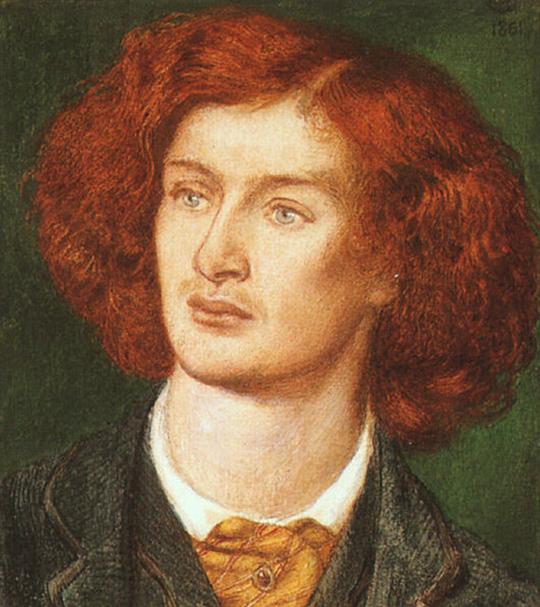
Painting of Swinburne by Gabriel Dante Rossetti, 1862.
The French have traditionally regarded biography as a rather low form, being either mere gossip, or at best a reductive process, one that tethers the work to the life, rather than recognising the extent to which the work flies free of it. The Anglo-Saxon tradition is more tethering and more moralising; the biographer’s overt or tacit intention too often being, as John Updike has put it, to “reduce celebrities to a set of antics and ailments to which we can feel superior”. Whereas it never occurred to Maupassant to feel superior, or think that Swinburne’s extravagant life in any way invalidated, diminished or necessarily coloured his work. This is partly a matter of Flaubertian aesthetics; partly the consequence of how the French saw, and to some extent still see, the British. They think of us as polite, unspontaneous beings trained to such control and self-control that sometimes the lid has to blow off, both in art and life. Hence our personal eccentricities and a line of artistic non-conformity. Contemporary British writers are still being fitted into this historic schema. I remember once trying to keep a straight face when a French journalist, seeking to place me in my proper English context, proposed that my key literary ancestors were Laurence Sterne, Lewis Carroll and Monty Python. Of course I enthusiastically agreed.
Maupassant never doubted that Swinburne was a genius. “He is a poet of exalted and frenzied lyricism, who is not in the least interested in the humble, decent reality which contemporary French artists obstinately and patiently seek; rather he strives to depict dreams and subtle thoughts which are sometimes ingenious and grand, sometimes inflated, but even so magnificent.” And it was the same when other British writers and artists of the time came up for French description and judgment. The French expected them to behave in peculiar ways, but declined to allow amusement or shock at their habits to affect aesthetic judgment. Jacques-Emile Blanche wrote of Sickert living in Dieppe for “thirty years, married, divorced, remarried, widower, or about to remarry”, moving between smart society and the obscure lodgings he shared with a red-haired fishmongress, and doing crazy things such as cutting off his hair to surprise a small girl; and in all those 30 years nobody ever saw him paint. None of this stopped the French accepting him as a true Dieppois and a true artist: “He was to be the painter of Dieppe. No other artist so perfectly felt and expressed the character of the town, whose Canaletto he has become.” Degas’s judgment on Wilde, after the 28-year-old Oscar had visited the painter’s Paris studio, was: “He behaves as if he’s playing Lord Byron in some suburban theatre.” Goncourt called Wilde un puffiste (a braggart, a blagger), and thought even his homosexuality wasn’t particular to himself, but imitative, if not plagiaristic: he had copied it from Verlaine, and also from Swinburne. The diarist Jules Renard wrote cuttingly, “He has at least the originality of being an Englishman” – the French never quite got hold of Wilde’s Irish connection. But while they saw him as a false human being, they judged him a true poet.
The British who disembarked at Dieppe the century before last were often surprised by the cheerful affability of the people they encountered. When Hazlitt was staying in Dieppe, “A man and woman came and sang ‘God Save the King’ before the windows of the Hotel, as if the French had so much loyalty at present that they can spare us some of it.” (Hazlitt correctly noted that a reciprocal gesture beneath the windows of a Brighton or Dover hotel would be highly improbable.) A year after the incident at Etretat, Swinburne returned to stay with Powell at the Chaumière de Dolmancé once again. In the town, he was “rather astounded at finding myself rushed at, seized by the arms and legs, hoisted and cheered, and carried all down the street with shouts of welcome, by the fisher folk and sailors who knew me again at once”. Powell said to him, “Why, don’t you know you’re their hero?” – a status Swinburne thought unmerited by the mere act of not quite drowning.
The poet memorialised his time on the Normandy coast in two ways. For the rest of his life he kept the “outsize garments” (outsize because he was so tiny) in which the rescuing fishermen had dressed him. And in his 1883 collection, A Century of Roundels, he published a poem called “Past Days”:
Above the sea and sea-washed town we dwelt,
We twain together, two brief summers, free
From heed of hours as light as clouds that melt
Above the sea.
The poem is partly a lament – for the dead Powell, and for passing time; also an idyll recreating “the days we had together” among “The Norman downs with bright grey waves for belt” and the “bright small seaward towns”. It is singularly lacking in references to monkey meat or Sadeian practices. Despite Swinburne’s considerable reputation in France, it seems that he and Maupassant never again met. What Maupassant, or his heirs, did with the flayed human hand is not recorded.
1. [Maupassant's 1882 short story "L’Anglais d’Etretat" has been translated into English by Elliot Lewis especially for The Public Domain Review, and is published under a Creative Commons Attribution 3.0 license]↩
Julian Barnes is the author of three books of stories, books of essays, a translation of Alphonse Daudet’s In the Land of Pain, and numerous novels, including Metroland published in 1980. His recent publications include Pulse, a collection of short stories, and The Sense of an Ending, winner of the 2011 Man Booker Prize. In France, he is the only writer to have won both the Prix Médicis and the Prix Fémina, and in 2004 he became a Commandeur de l’Ordre des Arts et des Lettres. In England his honors include the Somerset Maugham Award and the Geoffrey Faber Memorial Prize. He has also received the E. M. Forster Award from the American Academy and Institute of Arts and Letters and the San Clemente literary prize. In 2011 he was awarded the David Cohen Prize for Literature. Awarded biennially, the prize honours a lifetime’s achievement in literature for a writer in the English language who is a citizen of the United Kingdom or the Republic of Ireland.
published in 1980. His recent publications include Pulse, a collection of short stories, and The Sense of an Ending, winner of the 2011 Man Booker Prize. In France, he is the only writer to have won both the Prix Médicis and the Prix Fémina, and in 2004 he became a Commandeur de l’Ordre des Arts et des Lettres. In England his honors include the Somerset Maugham Award and the Geoffrey Faber Memorial Prize. He has also received the E. M. Forster Award from the American Academy and Institute of Arts and Letters and the San Clemente literary prize. In 2011 he was awarded the David Cohen Prize for Literature. Awarded biennially, the prize honours a lifetime’s achievement in literature for a writer in the English language who is a citizen of the United Kingdom or the Republic of Ireland.
Links to Works
The Englishman of Etretat (1882) by Guy de Maupassant
The Poems of Algernon Charles Swinburne, in 6 volumes (1904)

